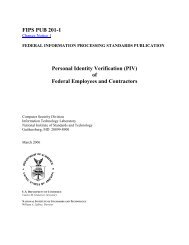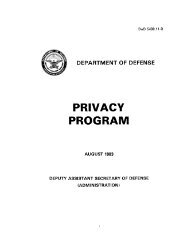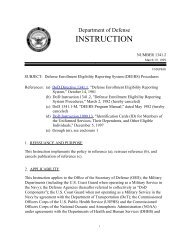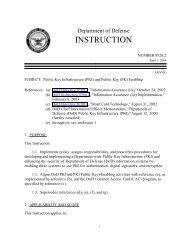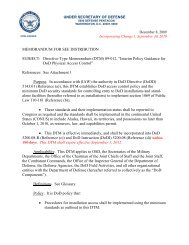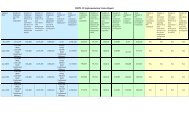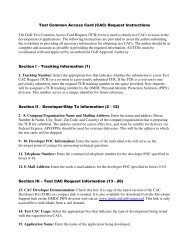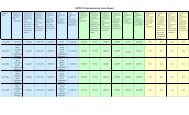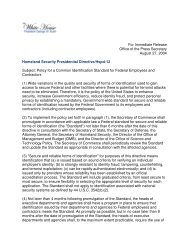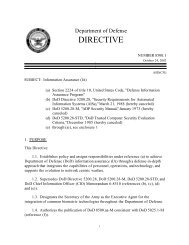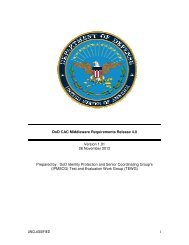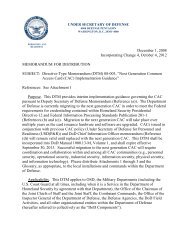DoD Instruction 8500.2 - Common Access Card (CAC)
DoD Instruction 8500.2 - Common Access Card (CAC)
DoD Instruction 8500.2 - Common Access Card (CAC)
Create successful ePaper yourself
Turn your PDF publications into a flip-book with our unique Google optimized e-Paper software.
DODI <strong>8500.2</strong>, February 6, 2003<br />
Subject<br />
Area<br />
Control Number, Name and Text<br />
Enclave and Computing Environment<br />
ECIC-1<br />
Interconnections among <strong>DoD</strong> Systems and Enclaves<br />
Discretionary access controls are a sufficient IA mechanism for connecting <strong>DoD</strong><br />
information systems operating at the same classification, but with different<br />
need-to-know access rules. A controlled interface is required for interconnections<br />
among <strong>DoD</strong> information systems operating at different classifications levels or<br />
between <strong>DoD</strong> and non-<strong>DoD</strong> systems or networks. Controlled interfaces are<br />
addressed in separate guidance.<br />
Enclave and Computing Environment<br />
ECLO-1<br />
Logon<br />
Successive logon attempts are controlled using one or more of the following:<br />
- access is denied after multiple unsuccessful logon attempts.<br />
- the number of access attempts in a given period is limited.<br />
- a time-delay control system is employed.<br />
If the system allows for multiple-logon sessions for each user ID, the system provides<br />
a capability to control the number of logon sessions.<br />
Enclave and Computing Environment<br />
ECLP-1<br />
Least Privilege<br />
<strong>Access</strong> procedures enforce the principles of separation of duties and "least privilege."<br />
<strong>Access</strong> to privileged accounts is limited to privileged users. Use of privileged<br />
accounts is limited to privileged functions; that is, privileged users use non-privileged<br />
accounts for all non-privileged functions. This control is in addition to an appropriate<br />
security clearance and need-to-know authorization.<br />
Enclave and Computing Environment<br />
ECML-1<br />
Marking and Labeling<br />
Information and <strong>DoD</strong> information systems that store, process, transit, or display data in<br />
any form or format that is not approved for public release comply with all requirements<br />
for marking and labeling contained in policy and guidance documents, such as DOD<br />
5200.1R. Markings and labels clearly reflect the classification or sensitivity level, if<br />
applicable, and any special dissemination, handling, or distribution instructions.<br />
Enclave and Computing Environment<br />
ECMT-1<br />
Conformance Monitoring and Testing<br />
Conformance testing that includes periodic, unannounced, in-depth monitoring and<br />
provides for specific penetration testing to ensure compliance with all vulnerability<br />
mitigation procedures such as the <strong>DoD</strong> IAVA or other <strong>DoD</strong> IA practices is planned,<br />
scheduled, and conducted. Testing is intended to ensure that the system's IA<br />
capabilities continue to provide adequate assurance against constantly evolving<br />
threats and vulnerabilities.<br />
Enclave and Computing Environment<br />
ECNK-1<br />
Encryption for Need-To-Know<br />
Information in transit through a network at the same classification level, but which<br />
must be separated for need-to-know reasons, is encrypted, at a minimum, with<br />
NIST-certified cryptography. This is in addition to ECCT (encryption for confidentiality).<br />
IA Service<br />
Confidentiality<br />
Confidentiality<br />
Confidentiality<br />
Confidentiality<br />
Confidentiality<br />
Confidentiality<br />
96 ENCLOSURE 4, ATTACHMENT 5



